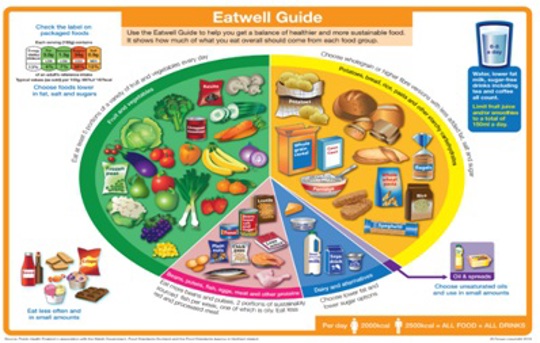If you have no symptoms, then it is unlikely that you will require surgery. Often dietary or lifestyle changes are recommended but there is no specific diet that will treat your gallstones. A healthy balanced diet that is naturally low in fat is recommended for all.
If you have symptoms, surgery is the most common form of treatment. Surgery may be to remove the gallstones, or remove the gallbladder. After a cholecystectomy (removal of the gall bladder) you do not need to follow a low fat diet.
Some people find that specific foods trigger pain, this can be very individual and you may wish to avoid these foods for a trial period to see if the pain reduces. However, there is no evidence that reducing the fat in your diet will necessarily reduce the pain.
Aim for a balanced diet based on the Eatwell Guide. The Eatwell Guide image shows the proportions of different food groups that make up a healthy diet.

Bread, rice, potatoes, pasta and other starchy foods
Starchy foods should make up just over a third of the food we eat. These are a good source of energy and should be a main part of every meal to prevent you from feeling hungry between meals. Choose wholegrain when possible.
Fruit and Vegetables
Aim for at least 5 portions of fruit and vegetables every day. This group should also contribute to just over a third of the food you eat each day. Fresh, tinned, frozen, cooked (e.g. soups) and dried all count towards your 5-a-day.
Milk and dairy foods
Choose lower-fat options where possible or have smaller portion sizes of standard products less often.
Meat, fish, eggs, beans and other non-dairy sources of protein
Choose lean cuts of meat; remove skin and visible fat from meat. Consider cooking method – grill, bake or poach instead of frying. Avoid or limit intake of processed meats, for example pies, sausages, bacon and pâté, which are high in saturated fat.
Oils and Spreads
Choose reduced fat spreads, such as Flora Light, Bertolli Light or half fat butters, and use oils and spreads
sparingly.
Foods to have less often and in small amounts
Foods high in fat and sugar such as cakes, pastries, biscuits and confectionery.
Food labelling
Traffic light coded labels on food packaging can highlight if a food is high (red), medium (amber) or low (green) in calories, fat, saturated fat, sugar and salt. This can help you to make healthier choices, by choosing foods with more green and amber and having those with reds less often or in small amounts.




